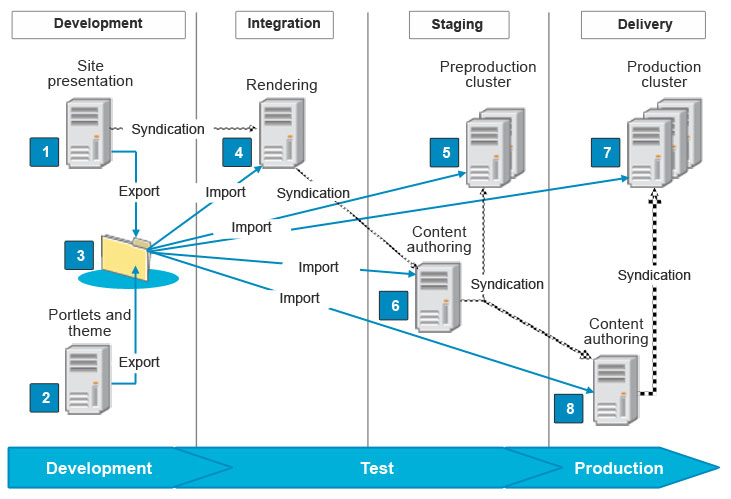Stage to production process
- Overview
- Initial and differential releases
- Push updates without affecting a live production environment
- The Web content development environment contains
- Presentations
- Authoring templates
- Taxonomies
- Content libraries
- Content components such as personalization components
- Personalization rules
Staging to production...
- The Portal development environment:
- Portlets
- Extensions
- Themes
- Applications
- The export directory holds source artifacts, including WCM artifacts. We can either compress this directory and import it to the other staging environments or build a PAA file.
- Use the rendering environment to test the rendering of WCM and portal development artifacts together.
- Use the preproduction environment to test everything on a cluster configuration that mirrors the live cluster.
- Use the Content Authoring environment to test the syndication process before moving to the production environment. This environment is the first place where we can test the full content of the site, including page structure and web content. The authoring (6) and rendering (5) environments are also good for performance testing.
- The production cluster environment is the live website cluster.
- The authoring environment is where content developers and editors develop new content and content updates for the site.
The initial release
The initial solution release moves all artifacts from the source portal to the staging target, which is assumed to be empty. An empty portal does not hold any application payload. There are procedures in place to allow a clean portal installation and to prepare it as target for an initial staging step. We export artifacts from the source, and import to the target. Typically an initial release contains the following data:
- Custom code libraries
- WAR or EAR files with custom extensions and/or themes and skins
- Portlet WAR files
- WCM libraries
- Portal content in an XML file, created with xmlaccess.sh
- Personalization rules
The differential release
Updates to the portal solution can include creating, modifying, or deleting artifacts such as pages, portlets, rules, and web content. While the new content can be deployed as a full release, this option would have the following drawbacks:
- Removing all release data, and deploying a new full release is time-consuming. Deploying deltas is more efficient.
- Customizations on the target can get lost.
Initial release configuration data is exported into an XM file configuration file using xmlaccess.sh. During staging of follow-on releases, a differential release is created by comparing new and old exports using ReleaseBuilder.
Web content updates are done using WCM syndication feature. If managed pages are enabled, syndication also transfers page artifacts.
Push updates without affecting a live production environment
Use an active/passive configuration with two PROD rendering enviroments, one which is live to end users (PROD-A), the second which is not live, and has changes made to it (PROD-B). During a deployment window the changes are made to the passive environment. Once the changes are made, and validation testing passes, update the DNS records to have the external hostname point to the passive environment (PROD-B), which now becomes the active environment. Should something unexpected go wrong on the recently updated environment (PROD-B), use DNS to revert back to the environment which had no changes made to it (PROD-A).
Active/passive offers low risk means of pushing changes between environments. The primary disadvantage is cost - approximately double the hardware and software costs for a second PROD environment 0 in addition to overhead to maintain a second environment. Further, the Portal servers are not the only servers which would need to be duplicated in an active/passive consideration. Consider duplication of deployment managers, web servers, load balancers, LDAP servers, database servers, etc. in addition to the Portal servers.
Parent Overview of staging to production
Related concepts:
Web content administration tools
